The content of the article
How to grow oyster mushrooms at home? According to a certain technology. Then you don’t have to spend money to buy mushrooms. And certainly it will be possible to safely eat them without fear of poisoning.
Where to begin
You should always start by getting acquainted with the experience of other people, so to speak - studying the materiel. There are many articles and videos about growing oyster mushrooms at home. After familiarization you will need:
Two rooms. One directly for growing, the second for the incubation period. It is assumed that this will be one room. Then it is necessary to strictly observe the temperature regime and adjust the level of humidity.
- Nutrient substrate. Ready, packaged for sale.
- The mycelium itself. Pay particular attention to the expiration date.
- Fan. The most ordinary household.
- Antiseptic. Medical alcohol or chlorine solution.
- Rubber gloves, gauze bandage for the face, a sharp knife, dense plastic bags.
Naturally, you have to stock up on patience (the process is not one day) and the desire to taste oyster mushrooms grown by hand.
Room requirements
To grow mushrooms at home, you need to allocate a separate room. It does not have to be a bedroom or a living room. Basement, cellar, barn, garage - all this fits perfectly. For the incubation period, the temperature should not be higher than 24-26 ° C, air humidity not more than 70%.
Separately, it must be said about cleanliness. Wash with bleach every centimeter is not worth it. It is better to process with a sulfuric smoke bomb or simply whitewash the walls with lime with the addition of copper sulfate. Then no extraneous mold will infect the mycelium.
The main condition is that all ventilation openings must be closed with a fine mesh. Mushroom flies and strive to fly to the aroma of mycelium and spoil the whole idea from the very beginning.
For the period of germination and harvesting, the humidity in the room should be at the level of 80-95%, the temperature should not exceed 18 ° С.
Tip. Basement or cellar - the most optimal facilities. In such places there is always high humidity, and the temperature can be increased by an ordinary heater.
Preparation of substrate for oyster mushrooms
As a nutrient medium for growing oyster mushrooms at home, you can use any substrate that is available, if only it contains cellulose. It is she who eats mushrooms. Experienced mushroom growers use sawdust, small branches or shavings. For beginners, it is best to use:
- barley straw
- husk of sunflower seeds
- corn stalks, leaves
- wheat straw
- buckwheat husk
- peeled corn cobs
First of all, you need to carefully sort through the prepared raw materials. The mass must be clean and dry. The presence of mold or the presence of only the smell of rotting already indicates that the raw material is not suitable for growing oyster mushrooms.
After the selection of the mass, it is necessary to process it thermally for reliability. This will get rid of harmful bacteria, insect larvae, and at the same time moisturize it. For this, raw materials are poured into metal dishes, filled with clean water. Heated to a boil, cooked for about 40 minutes. After leaving for 3 hours.
Then the excess water is drained, and the raw materials are placed under a press to remove residual liquid. Or they pour the substrate into a tissue bag and hang it.
As soon as the temperature of the mass drops to 24-26 ° C, you can begin to land.
Tip. For best results, a little fresh yeast is added to the raw materials before planting.Approximately 50 g per 15 kg of total weight.
Planting material
It is very difficult to cook good quality mycelium on your own. Therefore, it is better to buy it at seed shops or at oyster mushroom growing enterprises. How much gram is needed? The calculation is very simple. For 10 kg of raw materials, about 400 g of mycelium is needed.
First of all, before buying, you need to carefully inspect the package with planting material. Gray or black spots, a distinct smell of ammonia are signs of incipient mold. Such a mycelium is not suitable for planting. The color of the vegetative body of the fungus should be from bright yellow to orange.
It is not recommended to order planting material through online resources. Indeed, the photograph may not show what is in the package.
Tip. If the mycelium was purchased in advance, then it must be stored in the refrigerator until planting, no more than 9 days. The temperature of 3-5 ° C is the most optimal.
The most crucial moment
The substrate is prepared, the planting material is purchased and already lay down for 24 hours at room temperature. Take a deep breath, you can start.
Most importantly, the room should not have the slightest draft. Mushroom spores are very volatile. The slightest breath and then you can find oyster mushrooms in places that are completely unsuitable for them.
All instruments must be sanitized. Knife, tight bags, hands. You can wash it thoroughly with laundry soap or wipe with aseptoline. Hands can be additionally protected with gloves. They also need to be treated with an antiseptic. Be sure to wear a gauze bandage. The entry of fungal spores into the lungs is not a very pleasant event.
The process itself:
- Mycelium crumble without opening the bag.
- Raw materials are poured into the bottom of the prepared plastic bag.
- From above, a vegetative body of oyster mushrooms is laid out in a thin layer.
- Repeat layers to the top.
- The bag is tightly knotted.
In order for the mushrooms to sprout faster, it is advisable to lay out planting material closer to the walls of the bag than to the center.
You can do even easier. Pour raw materials into cooked bags, make small cuts with a knife. Mycelium is laid in them, then sealed.
Tip. Do not take huge packages. All the same, oyster mushrooms will grow only outside. The most optimal size holds about 5-8 kg of the finished mixture.
Incubation period
So, the bags are full, tied up, waiting for their fate. Which one? Heat, darkness, calm. In the incubation room, the temperature should not be higher than 18-20 ° C. The substrate is very hot, the vegetative body may die. It is impossible to ventilate the room, the emitted carbon dioxide is very important for the germination of oyster mushrooms.
What to do? Fan! It will save the situation, help cool packages, it does not drafts.
A day after the bookmark, previously made incisions are opened. If the mycelium was laid in layers, then it is imperative to make incisions with a sharp knife. Vertical 2-3 cm high, horizontal about 0.5 cm wide, the distance between them 10-12 cm.
Packages should not be close to each other. Between them leave a free space of at least 7-9 cm.
The incubation time depends on the variety, from 16 to 24 days. Detailed information can be obtained from the manufacturer, or read on the packaging.
It is important to periodically enter the room and inspect the bags. The appearance of black spots, an unpleasant odor suggests that the tools and materials were not sufficiently disinfected. The normal state is a light, almost white color of the contents, a characteristic pleasant aroma of mushrooms.
Tip. Inspection is carried out as quickly as possible. Any light is now undesirable for mycelium.
The first fruiting. Important aspects
It is important not to miss the moment the appearance of the oyster mushroom buds. They are visible to the naked eye. On a white background - gray tubercles. Meanwhile, packages of mushrooms are transferred to another room, or conditions are changed in the same:
- The temperature is reduced to 10-18 ° C.
- Increase air humidity up to 90-95%.
- They put artificial lighting with fluorescent lamps for a period of at least 8 hours per day.
- Be sure to ventilate the room. At least 4 times a day.
The main factor for the period of the first fruiting is humidity. However, you can not water oyster mushrooms. They can rot without reaching their size. An ideal way out of the situation is to often spray walls, floors, and spray water in the air. It should be ensured that water does not get on the mushroom caps and bags.
Tip. If oyster mushrooms are needed in light color, then the temperature is kept at 12 ° C. To obtain a dark hat, the temperature is raised to 18 ° C.
Second fruiting
After the first crop is harvested, the mushroom blocks are not thrown away! Oyster mushroom gives from one planting up to 5 crops. The mushroom picker rests for about 12 days, then delights with a new portion of healthy treats. It is very important not to change the conditions during breaks between crops. Then one block can bear fruit up to 4 months.
And if there is no separate room
How to grow oyster mushrooms at home, if there is no separate room? Yes, also very simple! When did something stop the Russian man, if he needed to? There is no basement, so growing on stumps is an alternative.
This will require:
- Smooth stumps of non-resinous tree species.
- Planting material.
- A secluded garden spot with nice shade.
- Burlap, film.
- Enthusiasm is welcome.
The wood should be healthy, without mold, rot or rot. It is advisable that before use it lay no longer than 10 months. Poles are soaked in clean water for 3 days, pressing against oppression, so as not to emerge.
Then holes are made in the tree, best with a drill. Diameter is about 1-1.5 cm, depth is about 5-7 cm. Oyster mushroom planting material is poured inside, plug holes with moss. If there is no drill at hand, then just cut off the top end of the log 5 cm thick, apply a vegetative body. On top put the resulting cut. For reliability, you can strengthen the structure with nails.
The procedure is carried out in March. Before the logs are planted in the garden, they are folded into a pyramid, covered with burlap and film. Periodic airing, regular inspection for mold - the key to success. After some time, the mycelium will completely braid the wood, the stumps will turn white.
With the onset of warm weather (mid or end of May), the poles are planted in the garden. Choose shaded places: under the trees, grapes, on the north side of the buildings. Stumps are set vertically, buried in the ground by 12-15 cm. Damp foliage or soaked old barley grains can be placed on the bottom of the pits.
Care of logs consists only in careful watering of the soil around, if the weather is dry and hot.
Subject to technology, the first crop appears from the end of August. It lasts until mid-November, depending on the climate and weather conditions. For winter, the poles are covered with spruce branches or covered with leaves. Ideally - birch. They disinfect well and do not allow mycelium to rot.
Of course, this method is not suitable for the industrial cultivation of oyster mushrooms, but for home use it is very good. At low cost, you can get good yields. The only negative is seasonality. Oyster mushrooms do not grow under the snow in winter.
Tip. Such poles with clusters of oyster mushrooms can become an original decoration of the site. They can be prepared as long as there is enough free land. There are enough mushrooms for themselves and relatives and for sale.
A few nuances
- All work on the cultivation of oyster mushrooms is recommended to be carried out in a gauze bandage. Mushrooms secrete a large number of spores, which can lead to allergies.
- When harvesting, oyster mushrooms are twisted by hands from the substrate. When cutting with a knife, you can infect the mycelium with putrefactive bacteria, then you will have to forget about the next crops.The remaining mushroom roots also harm the mycelium. A large amount of moisture is lost through them.
- When the slightest signs of mold appear in one of the bags, you must immediately remove it from the room so that the others do not become infected.
- The spent substrate is an excellent fertilizer, it will be a pity to throw it in the trash. Take out to the garden or pour out in the garden - the right decision. By the way, the remnants of the mycelium next year can give a small crop of oyster mushrooms if you pour the mixture somewhere near a reservoir or under trees.
- When grown indoors, the most fruitful are the first two waves of fruiting. On the poles, the most prolific second and third year of cultivation.
Growing oyster mushrooms on your own at home is a very real thing. Just follow the instructions and enjoy the result!
Video: oyster mushroom growing technology

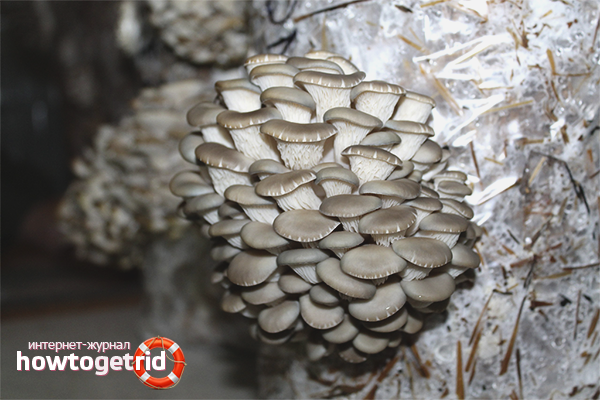
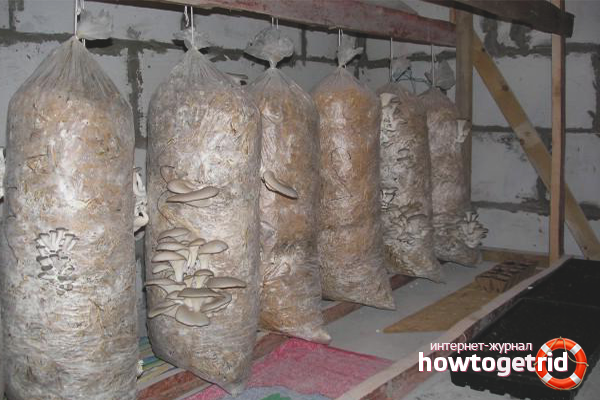

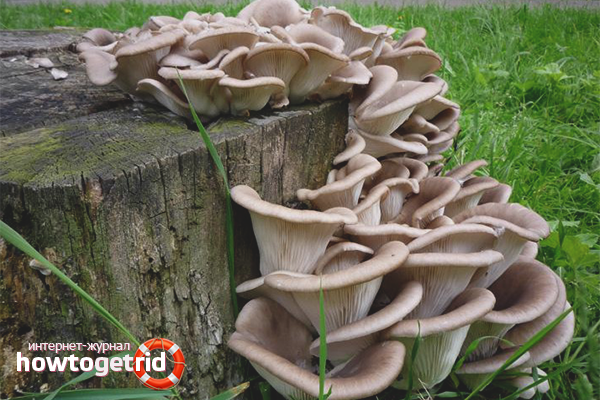

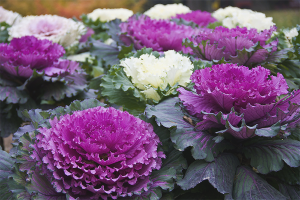
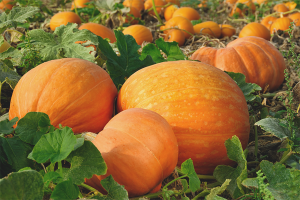
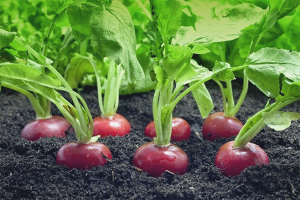

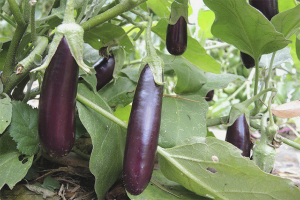
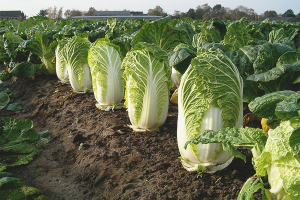
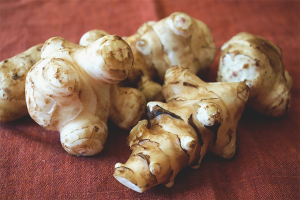
Submit